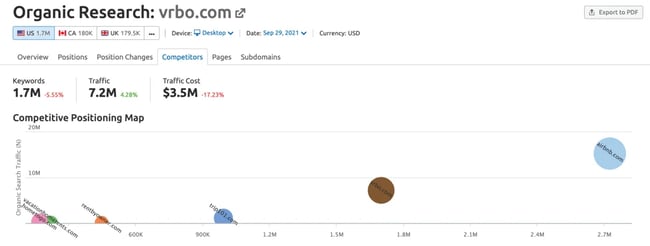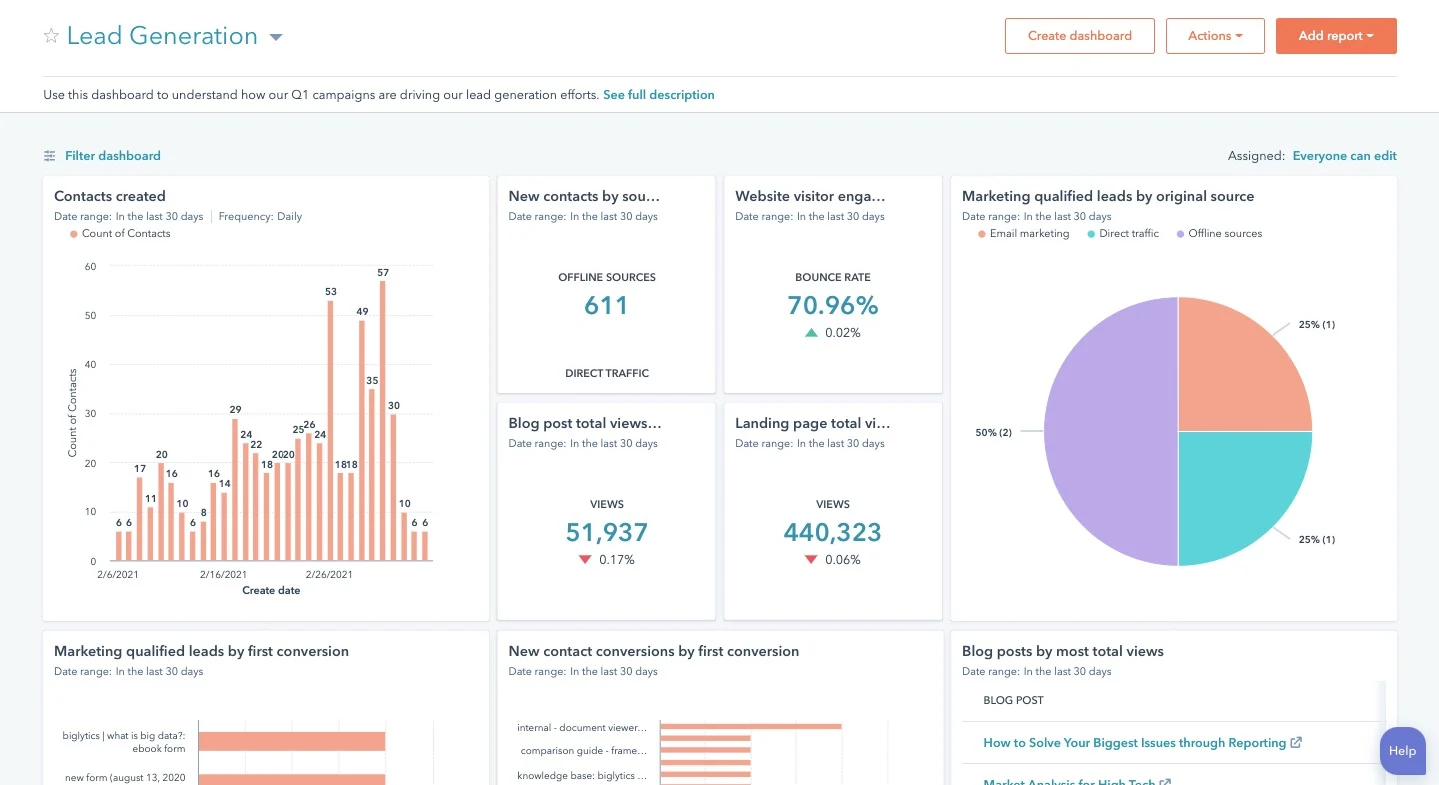How to Check Website Traffic
The exact process of checking website traffic depends on the tool you use, but some steps are the same. For the sake of this demo, we’ll walk through how to check website traffic using HubSpot’s traffic analytics tool, which is available with Content Hub.
1. In your HubSpot account, navigate to Reports > Analytics Tools.
2. Click Traffic Analytics.
3. To filter the data by time range and frequency, use the Date range and Frequency dropdown menus. These filters apply across all tabs of the traffic analytics tool.

4. Click into the Sources, Topic Clusters, Pages, UTM Parameters, Device Types, Countries, and Browsers tabs to view different types of traffic analytics data.
![]()
5. In each tab, you can drill down into different metrics, including sessions, bounce rate, and more.
Now that we understand the process of checking website traffic in HubSpot, let’s evaluate the best traffic analytics tools below.
1. Content Hub
Best for: Chart visualization
With HubSpot's traffic analytics tool, you can view traffic by topic cluster, source, device type, country, and more. You can also change the report's date range and frequency, export and save the report, and filter data by specific analytics views like country and subdomain.
What’s unique about this tool is that it allows you to change the chart visualization style. So say you’re looking at page views. You can choose an area chart, column chart, line chart, or a combination of an area and line chart to visualize the data.
2. Google Analytics
Best for: Real-time analytics
Most analytics tools will allow you to check your overall website traffic, or your traffic within a certain time period. But Google Analytics is unique in that it will not only track user volume by day and hour — it will also track the number of users on your site right now, and which pages they’re viewing. You can also see their geographic locations, the keywords and sites that referred them, and conversions as they happen.
This real-time reporting enables you to monitor the immediate effects that new campaigns and site changes have on your traffic. You can see, for example, if new content or updates are being viewed, if a promotion is driving traffic to your site and app, or if a blog, tweet, or other type of social media post is affecting traffic.

3. SEMRush
Best for: Competitor traffic metrics
SEMRush is an all-in-one tool suite for improving visibility and discovering insights for SEO, PPC, keyword research, and competitive research, among other services. It excels in competitive research in particular.
You can analyze up to 100 sites from a custom list at one time, check their traffic metrics and compare them to your own and other competitors side by side. You can see what your competitors’ top pages are, what regions most of their traffic is coming from, and which referring sites are sending them the most traffic. You can also gather insights into your competitors’ audience and their activity, like what websites they visit while navigating to and from competitor sites and how much of their audience overlaps with other competitors.

4. Similarweb
Best for: Total traffic estimate
While some tools only estimate organic traffic (ie. traffic from search engines), SimilarWeb estimates total traffic. This allows you to see the different places that visitors come from before landing on your site. Possible channels include search engines, forums, social media sites, and other sources.
You can not only compare how much traffic each channel is driving to your site — you can also compare the average visit duration, bounce rate, and other metrics of each channel.

5. Ahrefs
Best for: Organic traffic estimate
Ahrefs is one of the best organic traffic estimation tools. It provides estimated monthly visits from Google worldwide, estimated number of keywords in the top 100 that the website ranks for in Google, and estimated traffic value (the equivalent cost of monthly organic traffic for the website if bought via PPC). Ahrefs’ estimates are based on ranking data from a database of 12 billion keywords, which is the largest of all similar tools in the market.
You should consider using Ahrefs with a total traffic estimation tool like HubSpot or Similarweb. If you notice that organic search is driving the majority of traffic to your site, you can use Ahrefs to dig deeper and see how organic traffic has changed over time, what pages for bringing the most organic traffic to your site, and more.

6. Brand Overflow
Best for: All-in-one SEO software
Brand Overflow was designed with two main goals: to enable SMB marketers and entrepreneurs to make informed decisions without overwhelming them with technicalities or vanity metrics and to equip SEO professionals with a powerful but affordable set of tools.
Like Ahrefs, it comes bundled with dozens of SEO tools, including a keyword explorer, backlink monitor, rank tracker, and traffic checker — but at a lower price point.

7. Sitechecker
Best for: Historical traffic overview
With Sitechecker, you can estimate website traffic, unique visitors, bounce rate, and other engagement metrics by different channels and in different historical periods. You can also see your top organic and paid keywords, referral and social traffic, and top competitors.
What’s important to remember when using Sitechecker is that it does not track traffic and other metrics in real time so estimates may differ from other tools like Google Analytics.
.webp?width=650&height=406&name=draft%20-%20Check%20Website%20Traffic%20(1).webp)
8. Website IQ
Best for: Year-over-year tracking
With Website IQ, you can get traffic statistics for the past decade and growth charts that show your trajectory year-over-year, month-over-month, and day-to-day. You can also move the slider at the bottom of these charts to zoom in on a specific time period. This allows you to easily notice growth trends and create realistic traffic goals.
.webp?width=650&height=406&name=draft%20-%20Check%20Website%20Traffic-2%20(1).webp)
9. Fathom
Best for: Bypassing ad-blockers
Most traffic analytics tools can only offer traffic estimates based on the number of visits by people who do not use browser plugins to block scripts. Since approximately 43% of internet users use ad blockers, that means most tools can only offer data for about half your visitors. Fathom, however, pioneered a method for by-passing ad blockers that enables you to see all your traffic data while still protecting your visitors’ privacy.
That means the data Fathom shows about visitors, views, average time on site, bounce rate, event completions, and other metrics is incredibly accurate.
.webp?width=650&height=337&name=draft%20-%20Check%20Website%20Traffic-3%20(1).webp)
10. Quantcast
Best for: Direct measurement
With Quantcast, you can view your traffic by platform (web and mobile web), country, time period, and more. Unlike most traffic analytics tools, which rely on panel-based data collection or sampling, Quantcast uses direct measurement. This method counts every pageview and cookie that visits your website in real time, so it’s more accurate than panel data and sampling.
.webp?width=650&height=424&name=draft%20-%20Check%20Website%20Traffic-1%20(1).webp)
Checking Your and Other Websites’ Traffic
There are dozens of traffic analytics tools you can use to check your website traffic and that of your competitors. Since each one has a unique purpose and set of features, you can use multiple in order to get the clearest and most complete picture of your website performance in terms of traffic and engagement metrics, like average time on site and bounce rate.
Web Analytics









![10 Ecommerce Website Performance Metrics to Track [+Trends & Data]](https://53.fs1.hubspotusercontent-na1.net/hubfs/53/Ecommerce%20Website%20Performance.webp)





